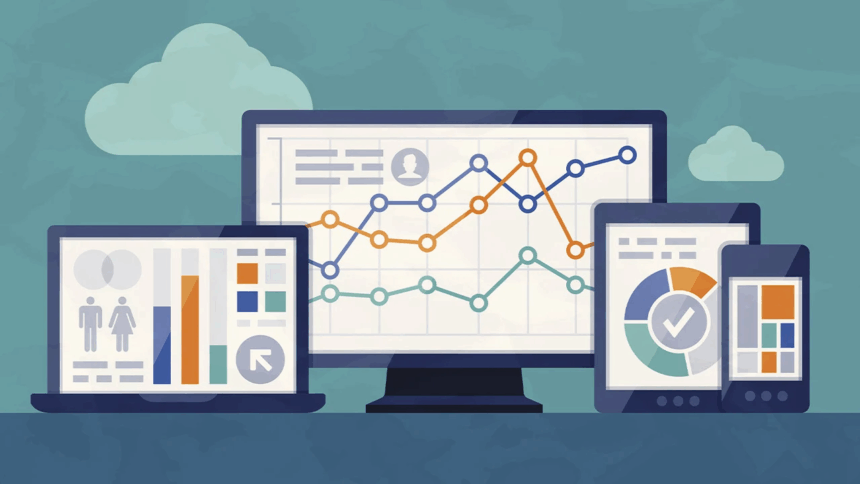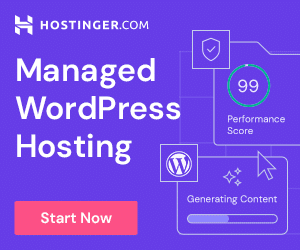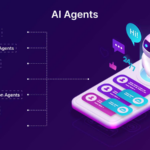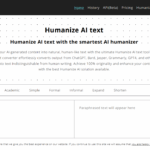In this article, I will cover Best Monitoring Software which helps companies make sure their IT infrastructure, applications and networks function seamlessly.
Software monitoring is critical for issue detection, performance optimization, and downtime prevention. Ranging from live notifications to comprehensive analytics, these programs offer extensive visibility and control, which is critical for the reliable and efficient operation of IT systems.
What is Monitoring Software?
Monitoring software is applications that helps to observe and track systems, networks, servers, or applications in real time and analyze the performance and security of the systems.
Identifying issues, pinpointing problems, and keeping the IT systems operating smoothly and effectively is the core value of monitoring software. Monitoring software value is in the ability to analyze CPU usage, memory and disk consumption, network traffic, application response times, and server uptime.
Monitoring software assists IT in averting downtime, managing performance, and preserving system consistence which in turn helps productivity and business operation.
Benefits Of Monitoring Software
Proactive Issue Detection – Solves problems before they escalate and cause costly disruptions and downtime.
Improved Performance – Puts a system and application performance monitoring to ensure they run efficiently and effectively.
Enhanced Security – Identifies abnormal patterns or breaches in security and protects sensitive information.
Resource Optimization – Monitors the CPU, memory, and storage to efficiently manage and prevent potential jamming.
Comprehensive Reporting & Analytics – Facilitates reporting and the use of dashboards to assist with reporting.
Regulatory Compliance & System Auditing – Detailed activity logs of system dynamics provide required evidence for authorities.
Reduced Cost for the IT Department – Proactive monitoring extends hardware life and reduces the frequency of emergency maintenance.
Improved User Experience – Maximizes performance and availability of applications and services for end-users’ satisfaction.
Best Monitoring Software Points
- Datadog: Provides real-time infrastructure and application monitoring with customizable dashboards.
- Zabbix: Offers open-source monitoring with extensive alerting and visualization capabilities.
- Nagios XI: Delivers comprehensive network and server monitoring with proactive alert management.
- Site24x7: Enables cloud-based monitoring of websites, servers, and applications with automated reports.
- Dynatrace: Uses AI-driven insights to optimize application performance and detect anomalies.
- LogicMonitor: Provides scalable infrastructure monitoring with predictive alerts and analytics.
- Prometheus: Offers open-source metrics collection and powerful querying for system monitoring.
- Icinga: Monitors network and server health with flexible notification and reporting options.
- Checkmk: Delivers automated IT monitoring with detailed dashboards and performance analytics.
- ManageEngine OpManager: Provides real-time network monitoring and fault management for IT environments.
10 Best Monitoring Software
1. Datadog
Datadog earns a spot as one of the best monitoring software because it provides one integrated solution that instantaneously tracks your infrastructure, applications, and cloud environments.
Combining metrics, traces, and logs into one unified view and enabling instant recognition and resolution of performance bottlenecks is what sets Datadog apart.
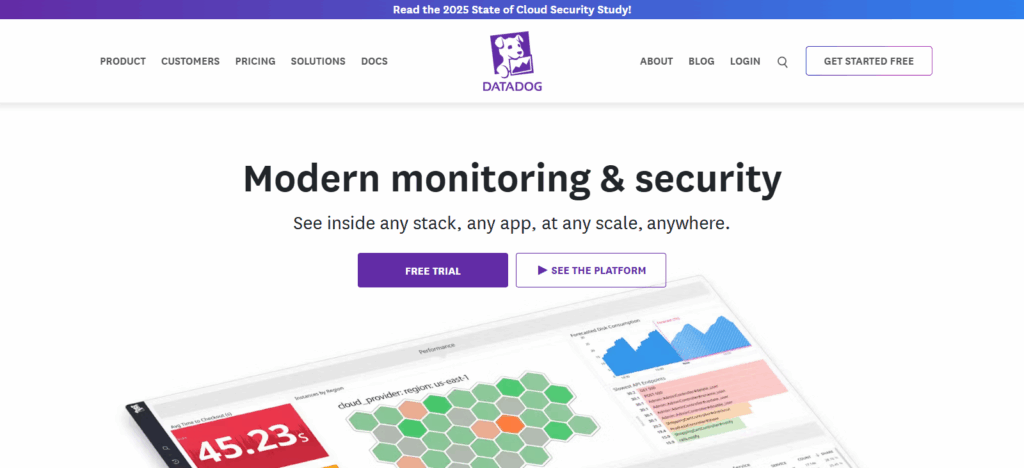
Datadog’s custom-tailored dashboards, predictive alerts, and seamless integration with hundreds of other systems and technologies provides a streamlined user experience.
Datadog is versatile and flexible ensuring your operational systems remain and increase economically efficient, reliable, and optimally resource efficient with little to no extensive user setups, maintenance efforts, and system downtime.
Datadog Features
- Unified Monitoring: Infrastructure, applications, and logs are consolidated into one platform.
- AI-Powered Alerts: Identifies anomalies and performance problems without manual setup.
- Custom Dashboards: Metrics can be visualized in adaptable and interactive dashboards.
2. Zabbix
Among the many available monitoring software options, Zabbix stands out for its robust performance as open-source software. Zabbix grants unrestricted access to the monitoring of your networks, servers, software, and cloud environments.
Its ability to provide customizable and flexible monitoring systems without charging software licensing fees. Zabbix’s real-time data collection, advanced alerting, and multi-channel dashboards allow quick issue resolution.
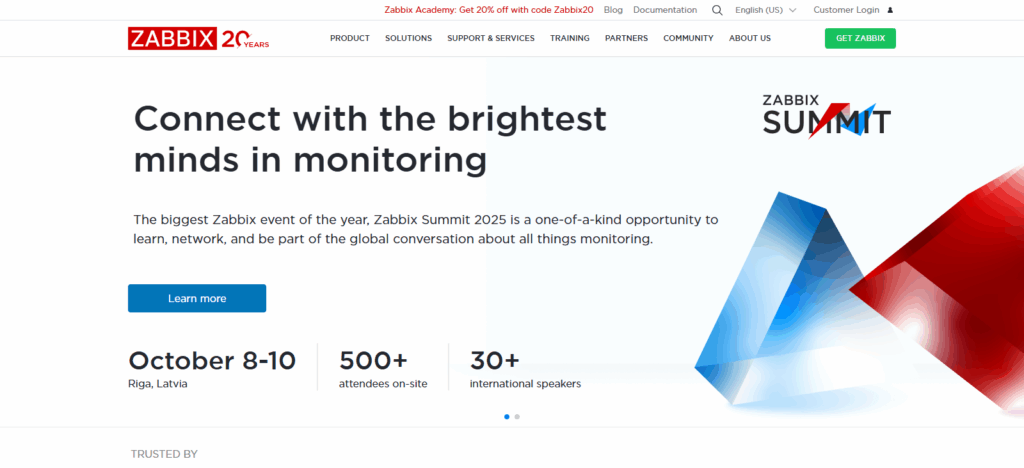
Automated problem diagnosing, advanced trending and analysis, and predictive monitoring provide Zabbix users with the ability to prevent outages well before they occur.
With various integrations and active community support, Zabbix offers dependable, scalable, and economical monitoring of infrastructure for IT modern-day organizations.
Zabbix Features
- Open-Source Flexibility: No licensing costs and complete customization are both possible.
- Real-Time Monitoring: Continuous monitoring of servers, networks, and applications.
- Advanced Alerting: Notifications without manual actions and escalations are possible through configurable triggers.
3. Nagios XI
Nagios XI is renowned as one of the best monitoring software, also because it provides complete enterprise level monitoring of networks, servers, applications and complete IT infrastructure.
It is different because of its advanced alerting system which not only identifies issues as they occur but also configurable alerts which guarantee expedited responses.
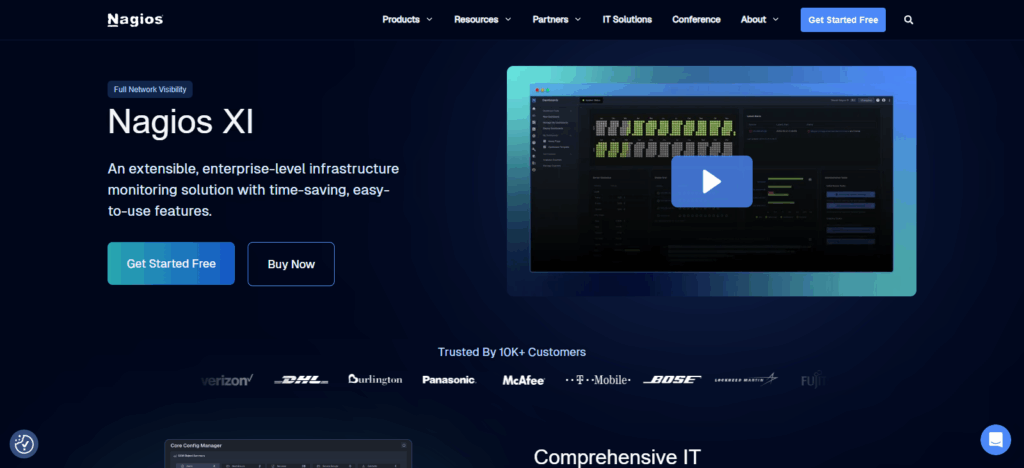
Nagios XI integrates monitoring with in-depth reporting, which includes capacity planning and trend analysis for effective proactive IT resource management.
Its modular design and thousands of available plugins provide the system with the ability to interoperate with numerous different systems, thus offering great flexibility and scalability. The considerable reliability and flexibility of Nagios XI is the reason it is well suited to guarantee system uptime and operational reliability.
Nagios XI Features
- Comprehensive IT Monitoring: A single platform is able to monitor networks, servers, and applications at once.
- Custom Alerts & Reporting: Users can set custom notifications and get expertly crafted reports.
- Plugin Ecosystem: Third-party integrations through plugins are supported extensively.
4. Site24x7
Site24x7 is one of the best monitoring software because of its all-in-one, cloud-based software that monitors websites, servers, applications, and networks in real-time.
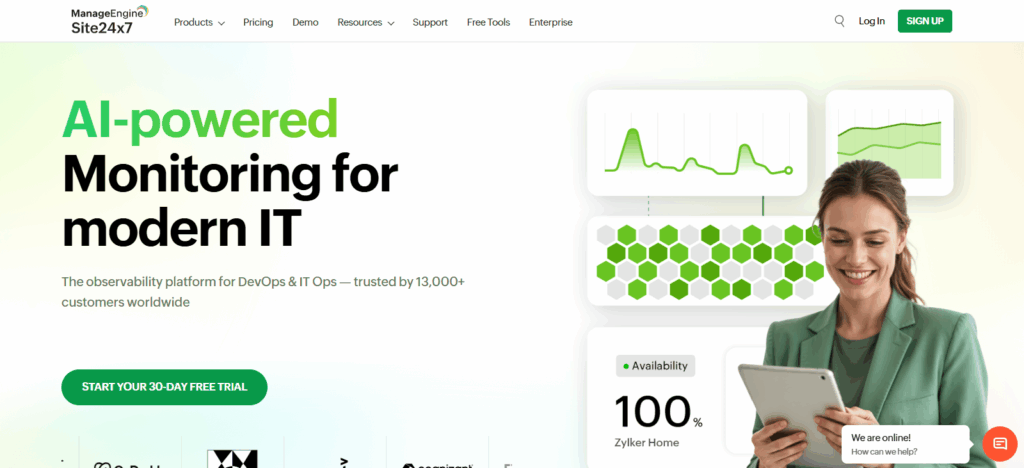
End-to-end visibility, including user experience and backend, cloud, and hybrid infrastructures, is its unique selling proposition, which is provided without complicated setups. Automated alerts, performance insights powered by AI, and customizable dashboards all come together for quick problem identification and system performance optimization.
For businesses that want seamless operations, reliability, scalability, and efficiency are essential, and built-in integrations for over 100 technologies, extensive reporting, and remote monitoring features provide just that.
Site24x7 Features
- Cloud-Based Monitoring: Websites, servers, applications, and networks can be monitored from the cloud.
- User Experience Tracking: End-user experiences for applications and websites are monitored.
- Automated Alerts & Reports: Performance assessments come with AI-based analytical insights.
5. Dynatrace
Dynatrace is one of the preferred monitoring software as it provides AI-driven, comprehensive observability across applications, infrastructure, and user experience.
Its distinguishing characteristic is the application of cutting-edge AI for the automatic detection of anomalies, determining the root cause, and offering actionable insights, thereby alleviating the need for manual troubleshooting.
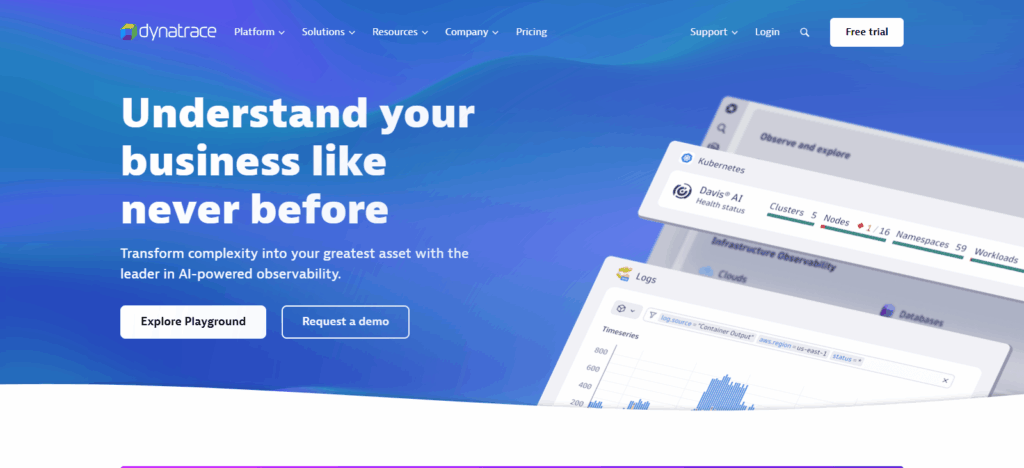
With real-time monitoring, the automated dependency mapping, detailed performance metrics, and end-to-end transaction tracing guarantee visibility in complex dynamic environments.
It is highly scalable and efficient due to automated monitoring and seamless integration with cloud, containers, and microservices. The effective prevention of downtime and performance degradation is made possible by the combination of comprehensive monitoring with automation and intelligent monitoring.
Dynatrace Features
- AI-Driven Insights: Anomalies are automatically detected along with the cause determination.
- Full-Stack Observability: Applications, infrastructure, and user experience are all monitored.
- Seamless Cloud Integration: Integration of Kubernetes, containers, and hybrid cloud environments are supported.
6. Logic Monitor
LogicMonitor is recognized as one of the finest monitoring software available because it offers automated, cloud-based, and expansion-friendly infrastructure monitoring.
Its unique feature is the predictive alerting system that identifies data-driven potential problems before they affect performance.
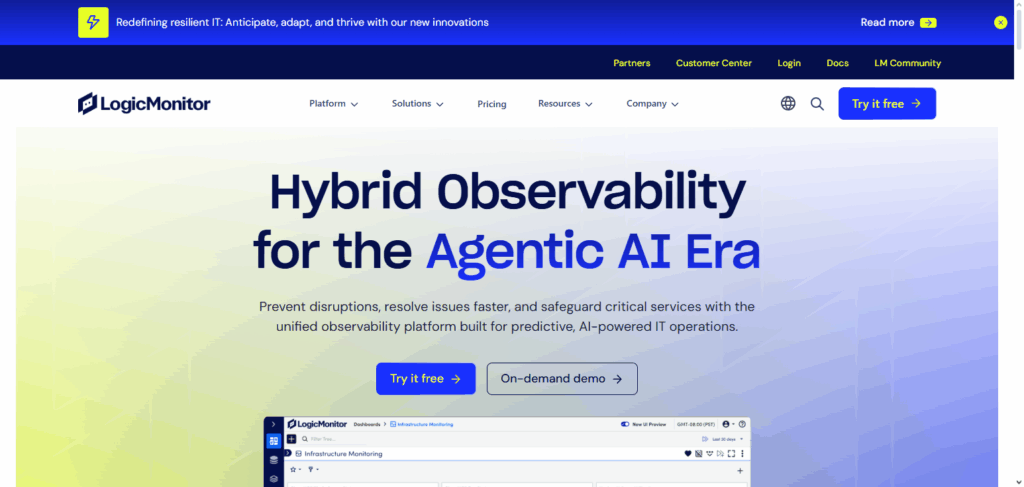
With easy-to-use customizable dashboards, reports, and integrations, clients will be able to access real-time updates on the status of their infrastructure.
By adapting real-time monitoring, historical trend analysis, and automated asset discovery, IT staff is able to refine forecasting and trend proactive resource optimization to lower downtime and enhance operational efficiency. Such proactive monitoring is exactly what enterprises of today need which is why enterprises of today need LogicMonitor.
LogicMonitor Features
- Automated Monitoring: Infrastructure monitoring becomes efficient with the auto-discovery of devices.
- Predictive Alerts: Employs analytics to foresee possible problems prior to their occurrence.
- Scalable Dashboards: Offers personalized dashboards and reports pertaining to every element of IT.
7. Prometheus
Prometheus is considered one of the best monitoring solutions because of its open-source, fully customizable architecture created for modern, fast, dynamic environments, such as cloud-native and containerized infrastructure.
The software’s strengths include its time-series database and query language (PromQL) enabling accurate metric definition, real-time analysis, and custom alert definition.
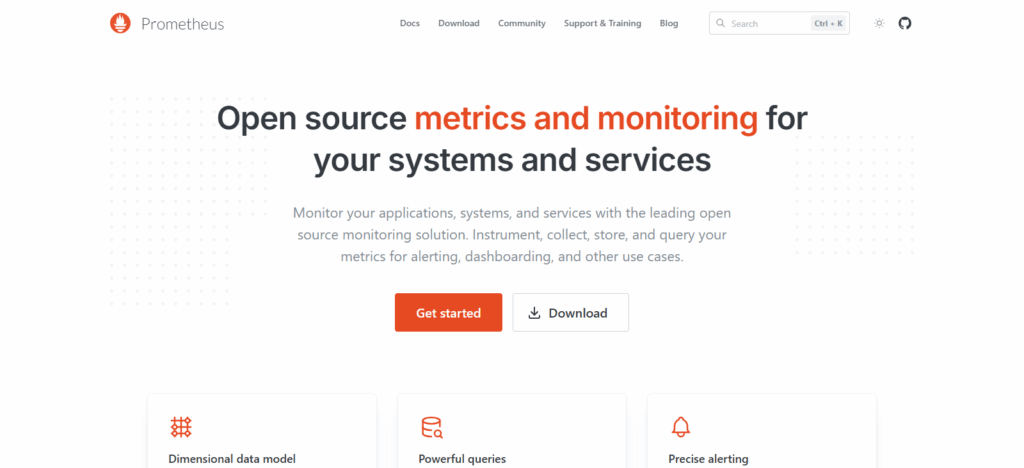
The monitoring of more intricate infrastructures is easier as Prometheus’s auto-discovery capabilities and seamless integration with cloud resources like Kubernetes and other cloud tools.
Its performance-storing and service-scaling capabilities, along with analytics and reporting, provide IT departments the tools they need to track performance, recognize and respond to anomalies, trends, and anomalies in real-time. Such flexibility, together with precision and reliability, contributes to Prometheus being a leading software solution for monitoring infrastructure.
Prometheus Features
- Time-Series Database: Efficiently gathers and maintains metrics and allows their retrieval through PromQL.
- Dynamic Target Discovery: Automatically detects services operating in cloud-native ecosystems.
- Alerting & Visualization: Works with Grafana to provide dashboards and custom alerts.
8. Icinga
Icinga stands out as a premier monitoring software solution. Its robustness and versatility allow Icinga to provide a comprehensive solution for IT monitoring and provide real-time visibility of networks, servers, and applications.
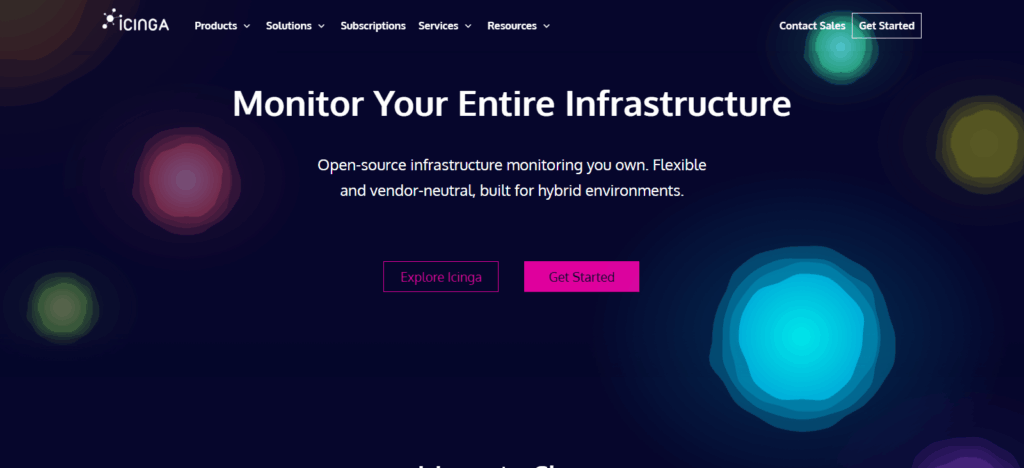
Icinga provides users individualized custom notifications, dashboards, and real-time cable monitoring, which gain users’ attention. Automated alerting, logging, and reporting tend to assist IT teams in trend and issue analysis and aid in resolving problems before they become operationally significant.
Icinga’s architectural modularity combined with its open-source character and numerous community modules provides limitless adaptability to multiple IT ecosystems and setups, guaranteeing enterprises’ systems reliability and optimal performance as well as resource efficiency.
Icinga Features
- Flexible Monitoring: Monitors networks, servers, and applications in real-time.
- Customizable Notifications: Offers custom alerts, flexible rules, and alters escalation policies.
- Modular Architecture: Allows for diverse IT setups with integrations and extensions.
9. Checkmk
Checkmk is considered top monitoring software for its fast, flexible, and automated monitoring IT infrastructure, applications and networks. Part of its strength is being able to offer detailed visibility with little user setup required, courtesy of auto-discovery and out of the box monitoring agents.
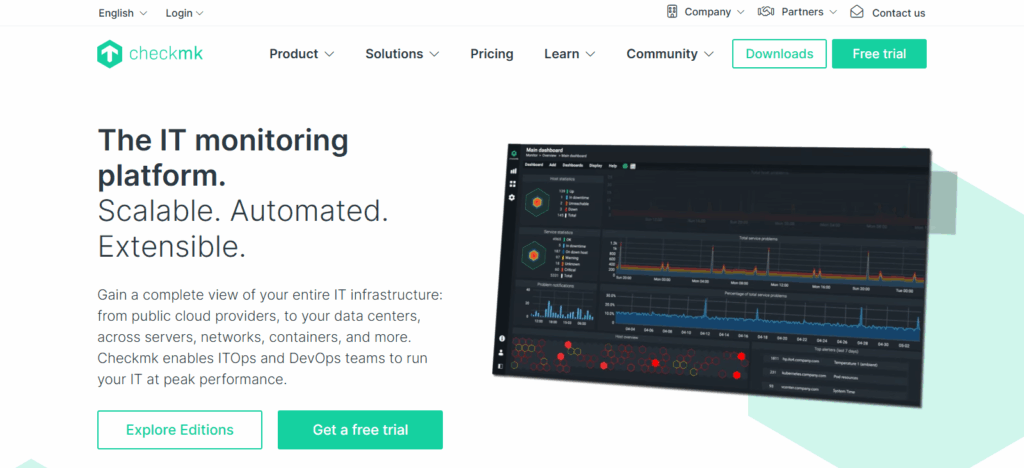
With detailed dashboards, real-time notifications, and comprehensive reporting, Checkmk equips IT teams to quickly identify and address issues and outages.
Checkmk is highly flexible due to its modular structure, which allows seamless integration with various systems and technologies. A combination of automation, deep insights, and scalability allows Checkmk to offer high performance, dependable, and proactive diverse IT systems management.
Checkmk Features
- Automated Discovery: Quickly identifies devices and services with little to no configuration.
- Comprehensive Dashboards: Advanced visual analytics and performance dashboards.
- Scalable & Modular: Works on large infrastructures and offers numerous tool integrations.
10. ManageEngine OpManager
ManageEngine OpManager is one of the best monitoring software because it offers comprehensive real-time monitoring of both networks and servers with an emphasis on efficiency.
Its ability to provide complete visibility of an organization’s IT infrastructure is unique along with the simplicity of actionable dashboards, automated alerts, and customizable detailed reports on various metrics.
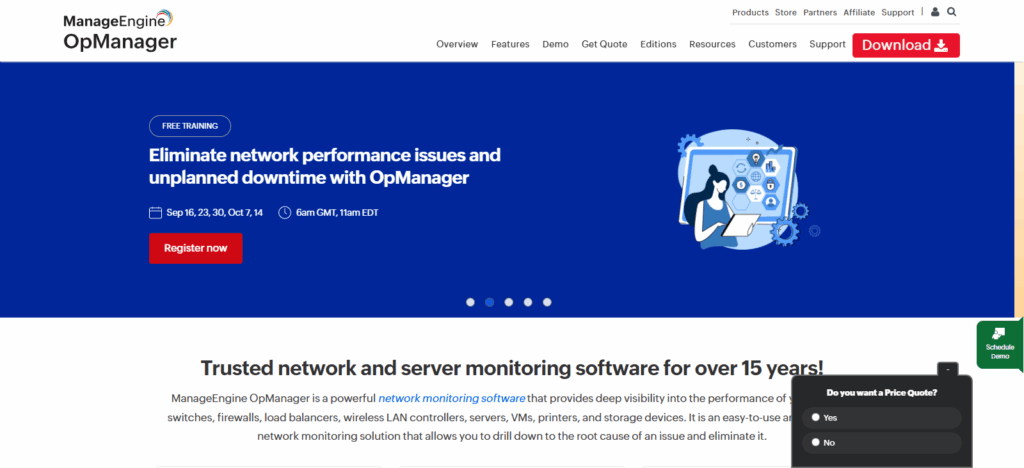
OpManager’s proactive fault detection, bandwidth management, and configuration control help IT teams resource optimization and downtime elimination, thus ensuring prevention uptime.
OpManager’s detailed visibility, automation, and simplicity of management provide unified IT systems that are monitored and optimized to perform reliably. Its resourcefully automated IT systems are easy to manage and are always kept well maintained.
ManageEngine OpManager Features
- Real-Time Network Monitoring: Continuously monitors servers, routers, switches, and firewalls.
- Fault Management: Automated alerts, root-cause analysis, and issue resolution.
- Performance Reporting: Creates reports and dashboards for decision-making.
How To Choose Monitoring Software
Identify the Need: Specify what components need to be monitored—whether servers, networks, applications, or cloud environments.
Growth Potential: Make sure the monitoring software can adapt to your infrastructure and accommodate additional loads.
User Experience: Seek out software with easy-to-navigate dashboards, streamlined setups, and straightforward reporting.
Real-time Alerts: Search for software that enables configurable, immediate notifications to help resolve problems.
Analytics and reporting: Assess the software to determine its capacity to deliver actionable reporting, detect trends, and perform root cause analysis.
Total Cost: Assess what the software will truly cost you, including licenses, maintenance, and potential hidden charges.
Vendor and Community Support: Take note of the support from the vendor, thorough documentation, and the presence of a lively community of users.
Conclusion
Finally, deciding upon appropriate monitoring programs is pivotal to ensure the continued health, performance, and security of the IT structure.
Monitoring Software such as Datadog, Zabbix, Nagios XI, Site24x7, and Dynatrace, aids with real-time monitoring, proactive alerts, and predictive analytics which greatly assist with resource optimization and downtime maintenance.
The appropriate monitoring solution will be reliable, scalable, and efficient, and allow rapid problem detection and resolution. Choosing monitoring programs that fit specific requirements will allow businesses to maximize operational performance, improve user experience, and enable uninterrupted IT operations.
FAQ
Why is monitoring software important?
It helps prevent downtime, detect issues early, optimize resources, improve performance, and ensure business continuity.
Which are the best monitoring software?
Some of the top tools include Datadog, Zabbix, Nagios XI, Site24x7, Dynatrace, LogicMonitor, Prometheus, Icinga, Checkmk, and ManageEngine OpManager.
How do I choose the right monitoring software?
Consider your requirements, scalability, ease of use, alerting features, integrations, cost, and vendor support.
Are there free monitoring software options?
Yes, open-source options like Zabbix, Prometheus, and Icinga provide robust monitoring capabilities at no cost.




